
Papua
Raja Ampat is more than just a destination; it’s an experience that will leave you breathless. It’s a chance to reconnect with nature’s raw beauty, a tapestry woven with sun-kissed beaches, vibrant coral reefs, and the whispers of a timeless culture. So, pack your sense of adventure, grab your snorkel, and let Raja Ampat weave its magic on you.


Some Papua Travel Highlights
- Snorkeling and Diving in Raja Ampat: Explore the worlds richest coral reefs, dive with manta rays, and swim alongside whale sharks in the heart of marine biodiversity.
- Raja Ampat Liveaboard Cruises: Explore remote islands and underwater wonders aboard a luxury liveaboard yacht.
- Misool Eco Resort: Stay at Misool Eco Resort in Raja Ampat for a luxurious eco-friendly experience that supports marine conservation.
- Trekking in Papua Highlands: Embark on challenging treks in Papua highlands, including the Carstensz Pyramid summit climb, offering stunning vistas of glaciers and alpine landscapes.
- Birdwatching in the Arfak Mountains: Witness the mesmerizing displays of birds of paradise in their natural habitat.
- Lorentz National Park Exploration: Discover the pristine wilderness of Lorentz National Park, a UNESCO World Heritage Site, and the stunning landscapes of the Sudirman Range.
- Village Stays: Engage in cultural exchanges by staying with indigenous communities in traditional villages.
- Traditional Art and Culture: Attend local festivals, visit art galleries, and experience traditional ceremonies to immerse yourself in Papua diverse cultural heritage.
Explore and enjoy the diverse culture, nature and uniqueness of Papua.
Misool
Diving Raja Ampat
Arfak Mountains
Lorentz National Park
Topography and Geology
Raja Ampat, which translates to ‘Four Kings,’ is an archipelago consisting of over 1,500 islands, islets, and cays. This region’s topography is a stunning testament to the forces of nature. The islands are characterized by limestone karst formations, mushroom-shaped islets, and dramatic sea cliffs that plunge into the crystal-clear waters.
These geological wonders create a surreal and captivating backdrop for explorers and adventurers. The islands of Raja Ampat are surrounded by pristine coral reefs, forming a marine paradise known for its exceptional underwater landscapes. The region’s unique geology has led to the development of some of the most biodiverse marine ecosystems on Earth.
Papua, the larger province encompassing Raja Ampat, is equally remarkable in its geological diversity. The province includes extensive mountain ranges, including the towering Jayawijaya Range. This range is home to the highest peak in Indonesia, Puncak Jaya (Carstensz Pyramid), and the third-highest of the Seven Summits.
Papua’s rugged landscapes, dense rainforests, and powerful rivers contribute to its rich geodiversity. The region is also known for its unique flora, including the famous Rafflesia arnoldii, the world’s largest flower, and exotic bird species such as the birds of paradise.
Biodiversity
Raja Ampat and Papua are synonymous with extraordinary biodiversity. The waters surrounding Raja Ampat are often referred to as the ‘Amazon of the Seas’ due to their unparalleled marine diversity. The region is a global epicenter for coral species, with over 75% of the world’s known coral species found here.
The vibrant coral reefs provide a habitat for an astounding array of marine life, from colorful reef fish to graceful manta rays and majestic whale sharks. The islands of Raja Ampat are also vital for marine conservation efforts. Misool Eco Resort, for instance, actively contributes to the preservation of marine biodiversity and sustainable tourism practices.
Papua’s terrestrial biodiversity is equally astonishing. The dense rainforests are inhabited by unique and endemic species, including tree kangaroos, cassowaries, and various birds of paradise.
Lorentz National Park, a UNESCO World Heritage Site that covers part of Papua’s highlands, protects an immense range of ecosystems, from glaciers to tropical rainforests. Both Raja Ampat and Papua are critical for global biodiversity conservation, and the preservation of these environments is essential for future generations.
Your travels to all of Indonesia’s parks, where well managed, can be a significant force in promoting local conservation efforts.
Human History and Cultures
The history of Papua is marked by its isolation and the richness of its indigenous cultures. The region has been inhabited for tens of thousands of years by various indigenous groups, including the Dani, Asmat, and Papuans.
These communities have developed unique languages, traditions, and art forms that reflect their deep connection to the land and environment.
Papua’s cultural heritage is particularly celebrated through its art, including intricate wood carvings, traditional musical instruments, and vibrant woven fabrics.
The Asmat people, known for their stunning woodcarvings, are one of Papua’s most renowned indigenous groups. Visitors can explore local villages to witness these living traditions.
In recent history, Papua has faced challenges related to governance, resource extraction, and political autonomy. The province remains an important center for discussions about indigenous rights, land ownership, and environmental conservation.
Ask us to design, curate and deliver a first class, unforgettable Indonesian Experience
